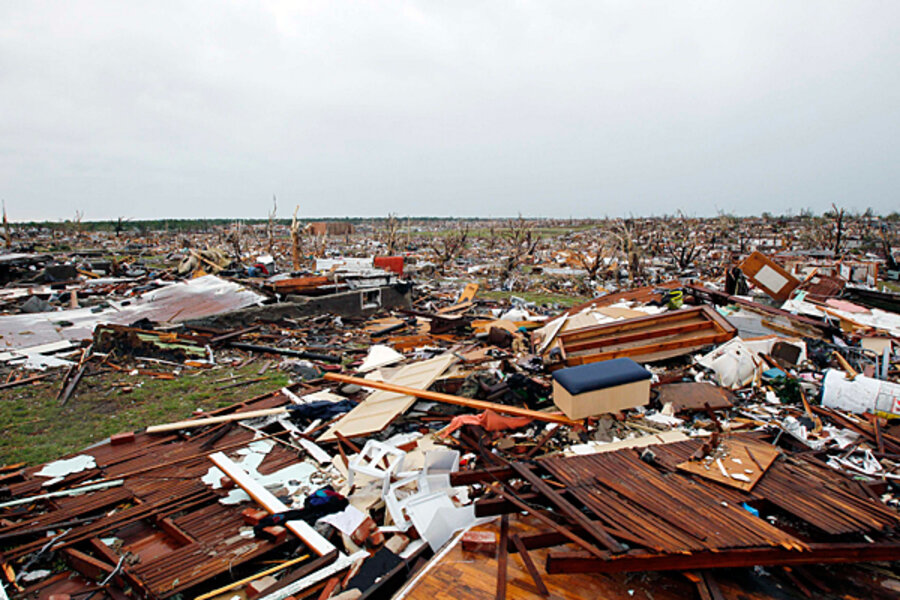Joplin, Missouri, tornado: Warnings pale in season of violent twisters
Loading...
A tornado that claimed at least 89 lives in Joplin, Missouri, on Sunday is part of a disturbing pattern in a spring of violent weather.
A series of tornado outbreaks in April and May have now killed more than 400 Americans. Officials in Joplin, which is still reeling from the tornado, say sirens went off about 20 minutes before the twister hit, but given the fluid situation on the ground, it's still not possible to know why so many people died.
On average, tornado deaths in the United States have gone from 8 per 1 million people in 1925 to 0.11 per 1 million people today – a trend largely attributed to early-warning systems fed by advanced meteorology and the introduction of Doppler radar.
Yet the stunning death tolls from tornadoes this spring raise new questions about government subsidies for storm shelters, the psychology of warning response, the possibility of limited tornado evacuations, and the argument that tornado warning and response should be considered a national security issue.
"As big as these events have been, people are putting politics aside and asking questions they weren't willing to ask a year ago," says Kevin Simmons, an economist at Austin College in Sherman, Texas, who has studied tornado casualty tolls. "After the Oklahoma City tornado in 1999, we were horrified by 36 people dying. We're now talking about hundreds."
The sheer power of the storm systems, which have been produced by unusual jet-stream dips bringing strong cold fronts into the Midwest and South, is the main factor in the death toll, researchers say. April saw a record-breaking 600 tornadoes spawn across the US, many of them powerful enough to crush houses and malls. Researchers have to go back to a massive 1974 tornado outbreak and then back to the 1930s to find storms of similar magnitude and impact.
"When an F4 or F5 tornado hits, there's not much you can do to change the outcome," Alabama Gov. Robert Bentley (R) said in April.
Yet researchers studying this spring's events are finding weaknesses in the overall ability of Americans to stay informed about looming tornadoes.
Widespread power outages ahead of the Alabama tornadoes last month probably prevented many victims from getting TV and radio warnings, says Mike Smith, author of "Warnings: The True Story of How Science Tamed the Weather." That raises a national security question, he says, about electric deregulation and its effect on the ability of utilities to restore power quickly.
"There's excellent evidence that many, many people did not get the warning in Alabama," says Mr. Smith, vice president of AccuWeather Enterprise Solutions, in Wichita, Kan. "I talked to person after person who told me, 'Thank goodness someone is paying attention to the power outage.' "
Bob Drost, a researcher at Michigan State University's Geocognition Research Laboratory, found in a study last year that personal experience with damaging storms is a major factor in determining how people respond to tornado warnings. "It’s comparable to biting into an apple with a worm in it," he told the university's news service last year. "Eating part of a worm will affect how you decide about eating apples for the rest of your life."
But the tornado warning system – and how it's applied by states and municipalities – may also be playing a role in affecting those attitudes. Smith calls it the "crying wolf" phenomenon. On Sunday, for example, tornado sirens went off in Lawrence, Kan., even though the area was outside the National Weather Service's tornado warning report. About three-fourths of all tornado sirens are false alarms, according to a National Weather Service study.
"It's important that we cut down the false alarm rate," Smith says. "We are inadvertently training people to not react when the sirens go off."
As happened in Joplin on Sunday, forecasters are now able to give people a 20-minute warning of a tornado strike. Researchers believe that the 20-minute mark is the "flattening-out point" for a warning's effectiveness, because longer lead times don't appear to have an appreciable impact on casualty tolls.
Still, a new generation of weather radars – being tested by the National Oceanic and Atmospheric Administration's National Severe Storms Laboratory in Norman, Okla. – offers the possibility of forecasting a tornado strike perhaps an hour ahead.
Such a breakthrough is already sparking debate about the possibility of ordering limited evacuations ahead of a tornado. Especially in populated areas like the places hit in Alabama and Missouri, such evacuations could probably save lives. But ordering people out of their homes to try to outrun an unpredictable tornado raises a whole array of questions about liability and safety trade-offs.
Policymakers are also likely to begin discussing government subsidies to help Americans in storm-prone areas, like the so-called Dixie Alley, build storm shelters. That entails a complex risk-reward analysis, including putting a price on human lives.
When considering human health subsidies, the government normally determines that a price of between $5 million and $10 million is worthwhile to save a single human life. As for the Alabama tornadoes last month, the government would have had to spend close to $30 million in tornado shelter subsidies per life saved, says Mr. Simmons at Austin College.





